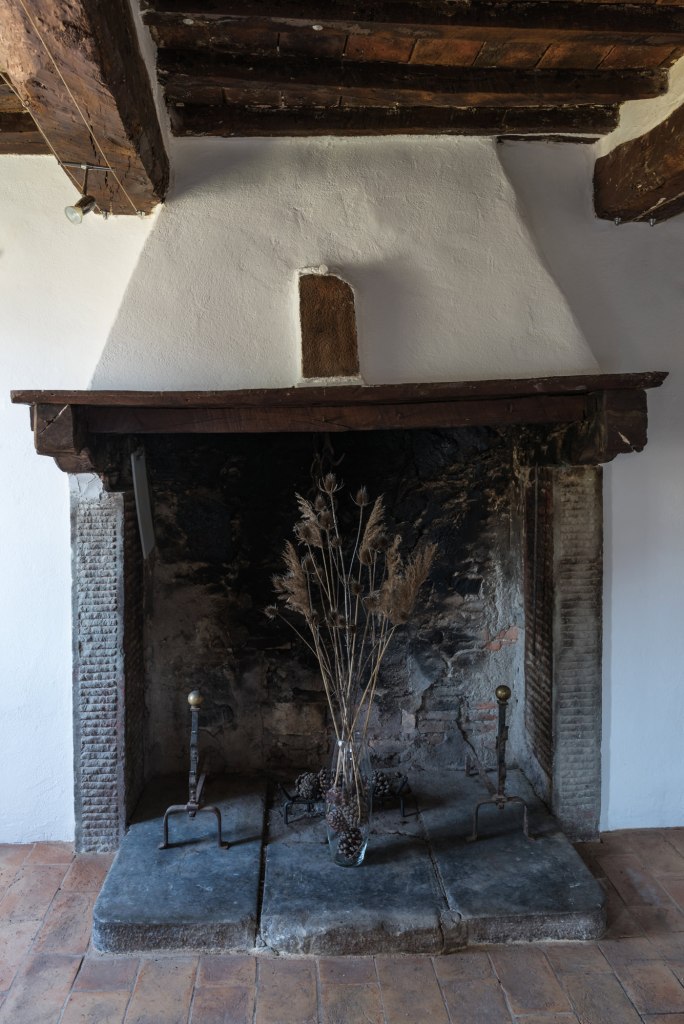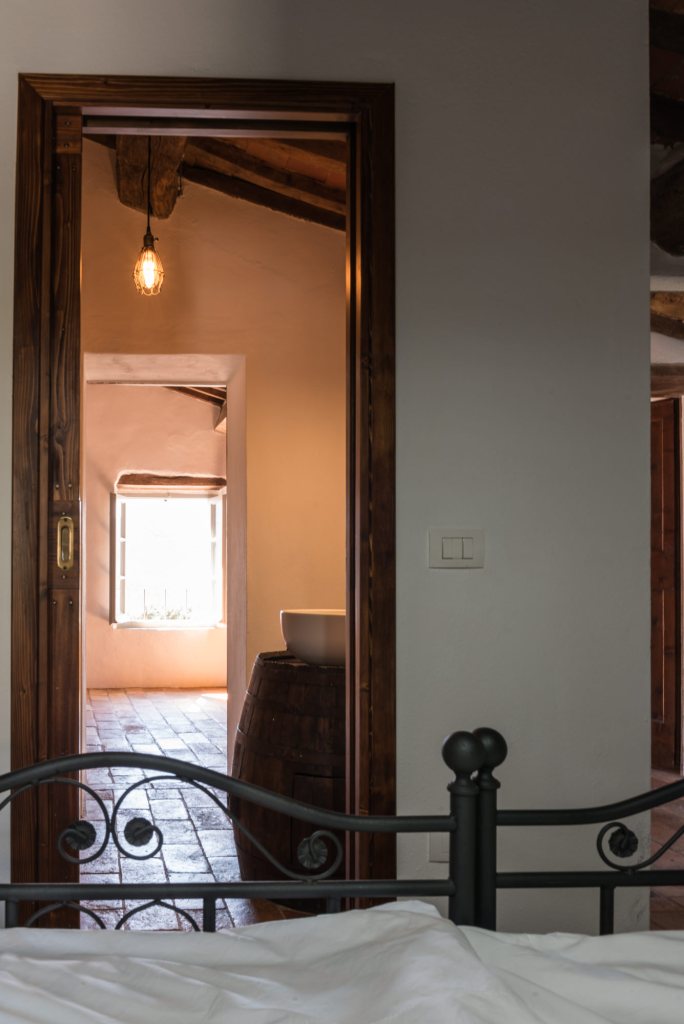This stone house in the Umbro-Tuscan Niccone Valley, built in 1869 just before the modern nation of Italy was born, was originally the home of farmers. Animals were kept in the basement and family life was focussed around the grand fireplace. It later became the schoolhouse for the hamlet of San Martino — indeed, one of the neighbours studied there. When agriculture was more labour intensive in the days before rural depopulation, a shop in the basement sold locally-produced tobacco and other everyday essentials to residents. Nails upon which hams were hung can still be seen in the rafters. Our Umbrian home is now being reluctantly offered for sale as we’ve returned to the UK due to work obligations.
San Martino nestles in birch forests at 400m above sea level, with sweeping views of the valley, a tributary of the Tiber. The stream forms the border between Umbria and Tuscany’s Perugia and Arezzo provinces, respectively. The peaks of Monte Ginezzo and Monte Castiglione separate the valley from the Val di Chiana and Lake Trasimeno at its western end. To the east stand Monte Acuto, with its 360 degree summit panorama above the town of Umbertide, and the mountains of the Le Marche Apennines. A little further down the Tiber Valley, on its slow, sinuous journey to Rome and the Tyrrenian Sea, lays Perugia, an Estruscan fortress city served by direct flights to London, Palermo, Catania and Tirana. The airport lays mid-way between Perugia and Assisi, and is a 45-minute drive from the Old Schoolhouse.



Lisciano and Pierle castles can be seen from the house, with more fortifications a few kilometres away at Sorbello and Reschio, hinting at the violent struggles of the region’s history. The modern valley hosts rolling vineyards and olive groves, crisscrossed by cycling and walking trails, along with excellent bars, bakeries, butchers and restaurants serving regional specialities including truffles, wine, olive oil, salamis, breads, cheeses, fruit and vegetables. These can also be enjoyed at home thanks to numerous local farmer’s markets and supermarkets.
The villages of Lisciano (Umbria) and Mercatale (Tuscany) are a few kilometres away, offering a choice of eateries, coffee hang-outs, gelato stops, take-away pizza and shops that cater for most household needs.


This area of the central Apennines offers hundreds of miles of quiet walking and trekking trails, centuries of art and culture, abundant wildlife, and world-class road, gravel and mountain cycling. It is the home of Slow Food and internationally famous gastronomic products, such as black and white truffles, porcini mushrooms, Norcia charcuterie, pecorino cheeses, Chianina beef, extra virgin olive oil, Valnerina lentils, Umbrian saffron, and Montepulciano, Sagrantino di Montefalco, Chianti and Montalcino wines, to name but a few.
In addition to the Italian staple of football, there are many other sporting events in the region. Cycling fans are particularly well catered for, with gran fondo, mountain and sportive events, a local road race calendar and the Strade Bianche events on ancient Tuscan gravel roads. There is also an active running scene, with races of all lengths.

The Old Schoolhouse
Fully renovated, restructured, repointed and reinforced from 2014 to date, the house offers two double bedrooms with shared high-specification Juliet bathroom and additional accommodation in a newly completed self-contained apartment. A large garden slopes gently downward toward the Niccone Valley and has mature fruit and olive trees. The roof was refurbished and a new chimney constructed. A seismic ring was added to the basement foundations and central heating has been installed on all levels. Modern, high efficiency appliances were specified throughout. Water pressure is maintained year-round by a powered autoclave pumping system, fed by a large reserve tank.






Kitchen, dining room and terrace
Still the focal point of the house, the kitchen and dining area was custom-built by local craftsmen. The shelving unit and storage areas were constructed with timber reclaimed from restoration projects in other old houses in Umbria and Tuscany. The stone worktop and sink were sourced from masons in the Medieval walled town of Città di Castello in the Upper Tiber Valley. Iron pot and curtain rails were also hand-made to order.
The Smeg gas range cooker helps foodies to do justice to the fantastic local ingredients, with ample storage in the full-sized A++-rated fridge-freezer.
A terrace runs along the front of the house, with breathtaking elevated valley, mountain, castle and forest views, our favourite venue for morning coffee and sundowners.










Lounge
The lounge retains its original bathroom window, admitting natural light when the main windows and doors are shuttered. The large archway to the kitchen and dining area links these spaces to form a large, open plan living area. Hand-made ironwork can hold a dividing curtain for greater flexibility. French doors open onto the terrace, overlooking the garden and Tuscan hills beyond. A pellet burner is fitted in the decorative fireplace.




Basement apartment
The cosy, self-contained downstairs apartment is rented out as an AirBnB property. Like the upstairs kitchen, the cooking area was custom-made to reflect local traditions, incorporating ancient reclaimed timber, hand-made ironwork and a beautiful original built-in cupboard that was relocated during the restructuring process. Set into the hand-made wooden worktop is an induction hob, with Smeg refrigerator below.
The modern bathroom is finished in custom-made reclaimed stonework and exquisite Apennine stone tiling from quarries around Assisi. Two sets of French doors provide views of the garden. The large bedroom area was remodelled from the old animal stalls and still features the original 19th century date inscription.
















Upstairs bedrooms
Reinforced floors are finished with antique cotto tiles. The wooden furniture echoes treated original roof beams. A large master bedroom enjoys stunning views across the valley, with plumbing in place for a luxury bathtub — what a way to enjoy the panorama across forests and mountains to Pierle castle!


The bathroom is finished to the highest specification with Italian artisan sanitary ware, rain shower head and Assisi stone tiling. A beautiful sink sits atop a wine barrel that was handed down with the house and is part of its history, now modified with capacious internal storage.


The second bedroom has beautiful partially-exposed fascia a vista stonework and a walk-in shelved cupboard, with an elegant sliding door to the shared bathroom.




Garden and utility room
The lean-to annex housing the utility area has been completely rebuilt. It houses a laundry room style sink unit, A+++-rated 8kg capacity washing machine, modern gas boiler and the pressurised hot and cold water system.
At the top of the garden is an area with the potential for erection of a substantial annex. A local geometra produced plans for a two-storey garden house, which could be revisited; water and electricity connections are already present and the construction of a swimming pool is also possible subject to lodging the appropriate project documentation with the authorities at the Lisciano comune. Another possibility discussed with local craftsmen is a summer kitchen and outdoor dining area. The lower area has agricultural classification, with several mature fruit and olive trees. It is a haven for flowers and wildlife as well as people.





Umbria – the ‘green heart of Italy’ – and Southern Tuscany
Umbria’s Estruscan and Medieval gems of Assisi, Gubbio, Todi, Orvieto, Perugia, Città della Pieve, Castiglione del Lago, Trevi, Spello, Spoleto and Montefalco are all within easy reach. There are year-round sagre (village food festivals) that showcase local products to raise funds for community activities. World-class cultural events include the annual Umbria Jazz in Perugia, Umbria Film Festival in Montone, Spoleto’s Festival Dei Due Mondi, Bevagna’s Il Mercato Delle Gaite Medieval festival, Cortona On the Move International Photography Festival and Gubbio’s Festa Dei Ceri. Permanent exhibitions include Estruscan archaeology in Perugia, Perugino’s frescoes in Città della Pieve and the Burri Collection of modern art in Città di Castello.
Some of Tuscany’s finest hill towns are a short journey from the Old Schoolhouse. Cortona, Montepulciano, Pienza and Anghiari are all within easy reach. Slightly further afield are Siena, Montalcino, Lucca, Pisa, San Gimignano and the Tuscan Maremma. Florence is around a one-hour train journey from Cortona’s mainline stations, with additional services from the local stations of Passignano and Tuoro Sul Trasimeno.
Regular mainline trains to Rome run from Perugia and Cortona. From Florence, there are high-speed links to Bologna, Milan, Salerno, Turin, Naples, Venice, Udine and Trieste. ‘Nightjet’ trains link the region with Vienna, Salzburg, Munich and beyond.
Le Marche region, with a border only 55km from San Martino, offers the high peaks of the Sibillini range, the Renaissance hill town of Urbino, the spectacular Grotte di Frassasi caverns, a riviera coast and Ancona, whose airport has direct links with London, Brussels, Munich and Tirana, and whose ferry port is a gateway to the Adriatic. Other airports serving central Italy include Pescara, Bologna, Florence, Pisa and two in Rome.
Beyond Cascia and Norcia in the stunning Valnerina lay Lazio and Abruzzo, with almost infinite potential for adventure.
Video tour of the Old Schoolhouse and Niccone Valley
Take a lightning tour of the house, see sunrise and sunset from the nearby summit of Monte Ginezzo, and watch an afternoon and evening in the valley pass in 10 seconds, viewed from the main bedroom window.